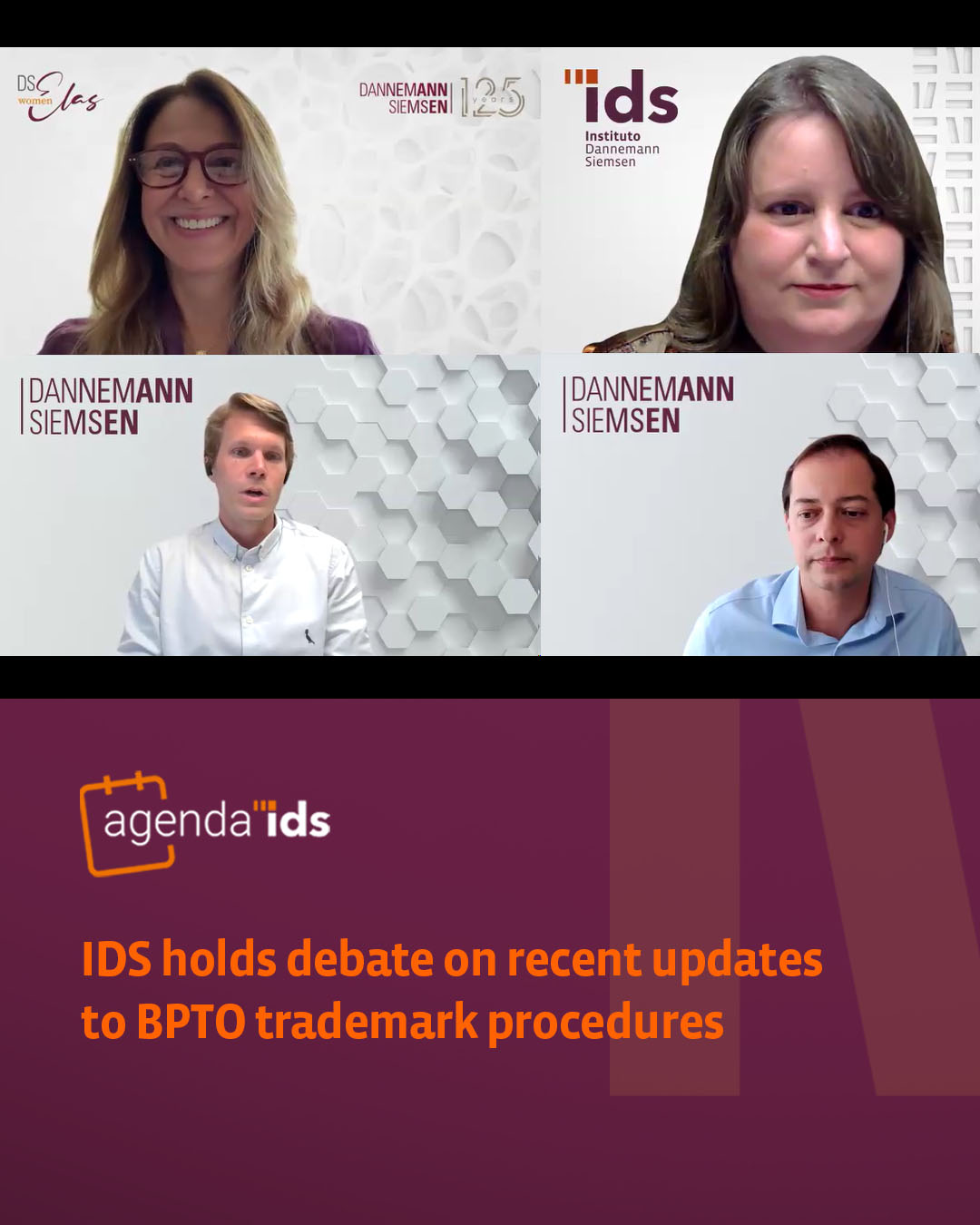07 de outubro de 2025
Share
IDS holds debate on recent updates to BPTO trademark procedures
On September 30, the Dannemann Siemsen Institute (IDS) held another edition of Agenda IDS, dedicated to discussing the recent updates implemented by the Brazilian Patent and Trademark Office (BPTO) in its trademark procedures. The virtual event featured an introduction by Patrícia Porto, Academic Coordinator of IDS; opening remarks by Elisabeth Siemsen do Amaral, Partner and member of the Dannemann Siemsen Board of Directors, as well as IDS Counselor; and presentations by Felipe Dannemann and Rafael Atab, both Partners at Dannemann Siemsen and IDS Counselors.
Elisabeth Siemsen emphasized that the changes implemented are not isolated measures but part of a broader modernization strategy by the BPTO. According to her, the six initiatives — registration of advertising slogans, recognition of acquired distinctiveness, priority examination of trademarks, simplification of the opposition system, criteria for high renown, and use of artificial intelligence — reflect the BPTO’s active listening to user demands while also imposing new strategic challenges on trademark owners.
Next, the guest lectures went on to detail the regulatory milestones and practical implications of the changes introduced by the BPTO. Felipe Dannemann analyzed the Trademark Manual update of November 2024, which introduced guidelines on the registration of advertising slogans. He explained that, although the Industrial Property Law (Article 124, VII) prohibits the registration of expressions used merely as advertising means, the BPTO has begun adopting a more flexible interpretation, allowing the registration of slogans capable of performing a distinctive function. Examples from the new guidelines were cited, such as “O melhor sapato do Brasil” (“The best shoe in Brazil”), which was refused for being purely promotional, and “Panamericano. Tudo por você.” (“Panamericano. All for you.”), which was deemed registrable for combining distinctive elements. Rafael Atab noted that the BPTO does not assess the truthfulness of slogans, unlike the European Union, which requires proof of environmental claims under the Green Claims Directive.
Still under Rafael’s lead, the discussion turned to the recognition of acquired distinctiveness, introduced by BPTO Ordinance No. 15/2025, dated June 3, 2025, and set to take effect at the end of November. The speaker explained that, until now, trademark applications refused for lack of distinctiveness could only have this aspect recognized through judicial review. With the new regulation, administrative recognition becomes possible, albeit under restrictive conditions. In this context, he mentioned the extraordinary 12-month period, starting from the entry into force of the ordinance, during which holders of pending applications or registrations under nullity proceedings may request an examination of acquired distinctiveness. Another limitation highlighted was the requirement for nationwide proof of acquired distinctiveness, which may hinder recognition of regionally established brands in a country of continental dimensions.
The event also included an analysis of BPTO Ordinance No. 27/2025, dated July 25, 2025, which established the priority trademark examination procedure, in effect since August 7, 2025. Felipe emphasized that the estimated two-month examination period under this regime places Brazil on a competitive international level. The procedure is requested through an electronic form and is structured in two acceleration modalities: one defined by law, addressing specific situations such as applications by elderly persons, and another based on strategic objectives and public policies, regulated by BPTO Ordinance No. 28/2025.
Subsequently, the project “Opposition 2.0” was presented, with its launch scheduled for December 2025. According to Felipe, the model aims to simplify the filing of oppositions based on Article 124, XIX of the Industrial Property Law, which are focused on defending the rights of previously registered trademarks owned by third parties and account for the majority of oppositions upheld by the BPTO.
On the topic of high-renown recognition, Rafael detailed the new parameters for brand image and market surveys, which now consider all regions of the country and different social classes. These guidelines were incorporated into the Trademark Manual on August 7, 2025, and establish minimum recognition thresholds of 61%, complemented by other evidence, while indices above 71% serve as reference values for recognizing high renown without the need for additional proof. The speaker highlighted the impact of these requirements on niche brands, particularly luxury brands, underscoring the need for substantial advertising investments to achieve such recognition levels.
Finally, the discussion addressed the use of artificial intelligence in trademark examination, scheduled to begin in September 2025. Felipe noted that this initiative could help expedite examination procedures, although its actual scope remains uncertain, given the challenges faced by IP offices worldwide amid the exponential growth in trademark filings.
The recordings of the event will soon be made available on the IDS website.
Note: For quick release, this English version is provided by automated translation without human review.
